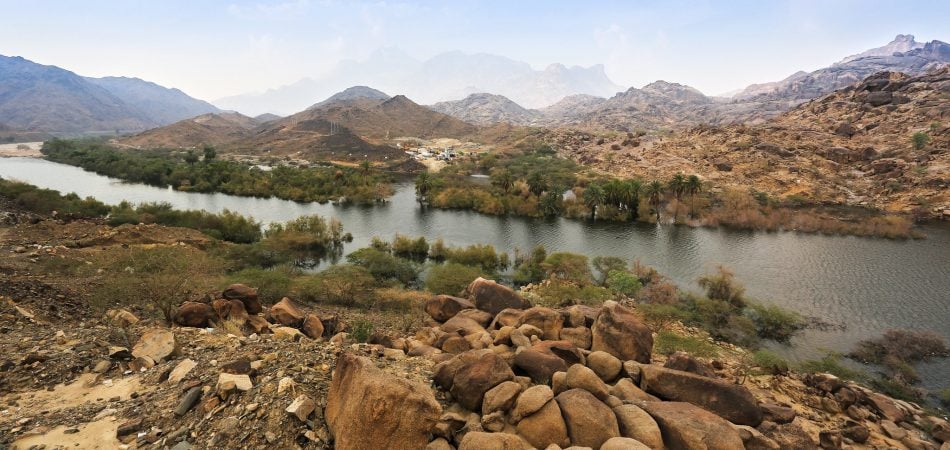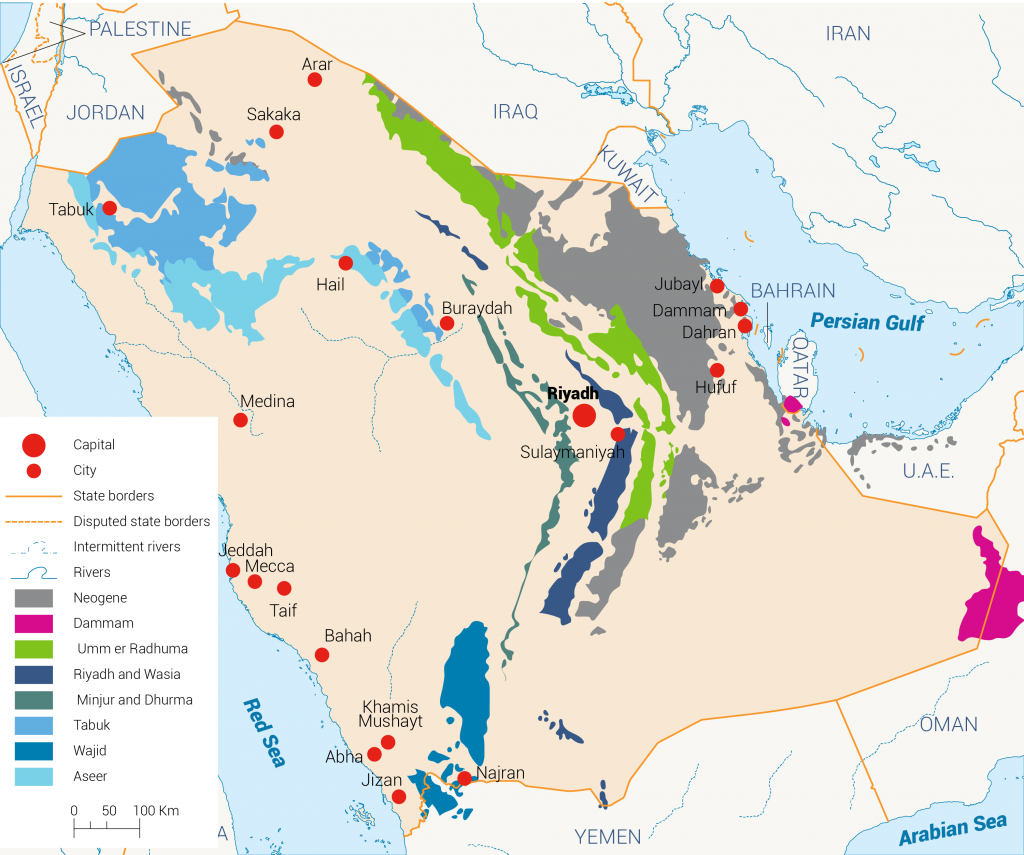
Harsh weather conditions, a high evaporation rate and limited rainfall means KSA does not have any permanent water bodies. Deep groundwater aquifers and desalination are the main water resources.
Surface water
Surface runoff at dams is the main surface water resource in KSA. The recorded average rainfall in 2019 was 59 mm, and the surface runoff at dams was estimated at 970 million cubic metres (MCM).[1]
There are 522 dams around the country, with a capacity of 2.3 billion cubic metres (BCM) to facilitate the storage and recharge of surface runoff. The total amount of the utilized water from dams is about 1.6 BCM/yr (more information on dams is available in the water infrastructure section).
Groundwater
Renewable groundwater
Most of the runoff infiltrates the ground to recharge the shallow aquifers located along the river valleys and beneath the alluvial fans and plains in various areas. These aquifers are generally unconfined, small in size and have water tables that respond rapidly to local precipitation. Some shallow aquifers are Khuf, Tuwail, Aruma, Jauf, Sakaka, Jilh and Jubaylah.[2] The total renewable groundwater is estimated to be 2.8 BCM/yr.[3]
Non-renewable groundwater
Groundwater in the deep sandstone aquifers is non-renewable or ‘fossil’ water, which is confined in sand and limestone formations of a thickness of about 300 metres at a depth of 150-1,500 metres. The deep rock aquifers are sedimentary in origin, usually sandstone and limestone, extending over thousands of square kilometres with poor natural recharge. Among these aquifers, Saq, Wajid, Tabuk, Minjur-Dhurma, Wasia-Biyadh, Umm er Radhuma and Dammam-Neogene are the principal aquifers. Map 1 illustrates the location of the principal aquifers.[4]
The capacity of fossil groundwater reserves has been investigated in many studies and estimated to be between 259-761 BCM with an effective annual recharge of 886 MCM.[5] As shown in Figure 1, fossil groundwater reserves have become exhausted over the past decades.
The average annual groundwater withdrawal rate is 20 BCM, while the annual recharge is only 2.8 BCM.[9] The additional quantity of groundwater is extracted from the fossil groundwater in Saq-Ram aquifer, which has a proven reserve of 103,360 MCM.[10]
During the last two decades, the water table in this aquifer has fallen by 60 metres due to heavy use by the agricultural and domestic sectors.[11]Both renewable and non-renewable groundwater is used primarily in the agricultural sector, which constitutes about 85% of total groundwater withdrawal. If current withdrawal rates are maintained, the available reserves will be depleted within 50 years.[12]
Non-conventional water resources
Desalinated seawater
Accounting for 18% of the global production by the end of 2017, KSA is among the top producers of desalinated water.[13] There are 35 desalination plants on the western and eastern coasts. The total capacity in 2015 was estimated at 6.28 BCM/d and was expected to reach 7.4 BCM/d in 2020.[14] Nearly 70% of the national water supply comes from desalination.[15]
The Saline Water Conversion Corporation (SWCC) is considered the largest producer of desalinated water and owns the majority of desalination plants in KSA, accounting for 73% of the total production capacity. To meet the potable water demand, which is expected to be 8.5 MCM/d by 2025, the SWCC is aiming to increase its installed production capacity to around 8.8 MCM/d by 2030.[16]
Treated wastewater
The overall quantity of municipal wastewater production increased from 2,125 MCM in 2007 to 2,884 MCM in 2018, and is expected to reach 5,090 MCM in 2050 due to population growth.[17] Wastewater is treated in a total of 99 wastewater treatment plants (WWTPs). The amount of treated wastewater (TWW) reused in 2019 amounted to 4.9 MCM/d, which is equivalent to 17.26% of the total TWW quantities (Table 1). The amount of TWW is predicted to grow about 4% annually between 2025 and 2050.[18]
Table 1: Regional distribution of WWTPs, TWW quantities and reuse in KSA.[19]
| Region | Number of WWTPs | TWW (MCM/yr) | Amount of treated water (MCM/d) | Amount of reused TWW (m3/d) | Wastewater reuse (%) |
| Riyadh | 15 | 540.111 | 1.480 | 137,575 | 9.30 |
| Mecca | 7 | 456.263 | 1.250 | 64,897 | 5.19 |
| Medina | 4 | 105.124 | 0.288 | 139,639 | 48.50 |
| Qassim | 5 | 79.887 | 0.219 | 59,819 | 27.33 |
| Eastern | 16 | 423.123 | 1.159 | 382,846 | 33.03 |
| Asir | 17 | 76.478 | 0.210 | 40,110 | 19.14 |
| Tabuk | 3 | 46.288 | 0.127 | 2,610 | 2.06 |
| Hail | 2 | 24.445 | 0.067 | 4,516 | 6.73 |
| Northern Border | 3 | 7.218 | 0.020 | 6.58 | 0.03 |
| Jazan | 13 | 21.749 | 0.060 | 8,020 | 13.46 |
| Najran | 3 | 4.237 | 0.012 | 10,621 | 91.50 |
| Baha | 9 | 0.492 | 0.001 | 742 | 55.03 |
| Jawf | 2 | 16.464 | 0.045 | 905 | 2.01 |
| Total | 99 | 1801.874 | 4.936 | 852,307 | 17.26 |
As shown in Figure 2, agricultural irrigation and landscape irrigation consume about 59% and 16% of the TWW, respectively.
Industrial water is equivalent to 13% of total water reuse, and 8.5% is used for recharging groundwater aquifers.
Figure 2: Water reuse sectors in KSA.[20]
[1] Ministry of Environment, Water and Agriculture, 2019. Statistical book: Year 2019 (1440-1441).
[2] Chowdhury S and Al-Zahrani M, 2015. Characterizing water resources and trends of sector wise water consumptions in Saudi Arabia. Journal of King Saud University – Engineering Sciences 27(1); 68-82.
[3] Ministry of Environment, Water and Agriculture, 2018. National Water Strategy 2030.
[4] Ibid.
[5] Ibid.
[6] Ministry of Economy and Planning, KSA, 2010. The Ninth Development Plan (2010-2014).
[7] Abderrahman, WA, 2000. Water demand management and Islamic principles: a case study. Water Resources Development 16(4): 465- 473.
[8] Abderrahman, WA, 2000a. Water demand management in Saudi Arabia. In: Farukui, NI, Biswas, AK, Bino, MJ (eds.), Water Management in Islam. The International Development Research Centre (IDRC), pp. 68-78.
[9] Chandrasekharam, D, 2018. Water for the millions: Focus Saudi Arabia. Water-Energy Nexus 1(2): 142-144.
[10] Chandrasekharam, D et al., 2016. Desalination of seawater using geothermal energy to meet future freshwater demand of Saudi Arabia. Water Resources Management 31: 781-792.
[11] Kajenthira, A et al., 2012. A new case for promoting wastewater reuse in Saudi Arabia: Bringing energy into the water equation. Journal of Environmental Management 102: 184-192.
[12] Ibid.
[13] Ng, KC and Shahzad, MW, 2018. Sustainable desalination using ocean thermocline energy. Renewable and Sustainable Energy Reviews 82: 240-246.
[14] Ministry of Environment, Water and Agriculture, 2018. National Water Strategy 2030.
[15] Ghanim, AA, 2019. Water resources crisis in Saudi Arabia, challenges and possible management options: An analytic review. World Academy of Science, Engineering and Technology International Journal of Environmental and Ecological Engineering 13(2).
[16] Ministry of Environment, Water and Agriculture, 2018. National Water Strategy 2030.
[17] Alkhudhiri A et al., 2019. Analytical and forecasting study for wastewater treatment and water resources in Saudi Arabia. Journal of Water Process Engineering 32, 100915.
[18] Ibid.
[19] Ministry of Environment, Water and Agriculture, 2019. Statistical book: Year 2019 (1440-1441).
[20] Alkhudhiri A et al., 2019. Analytical and forecasting study for wastewater treatment and water resources in Saudi Arabia. Journal of Water Process Engineering 32, 100915.

